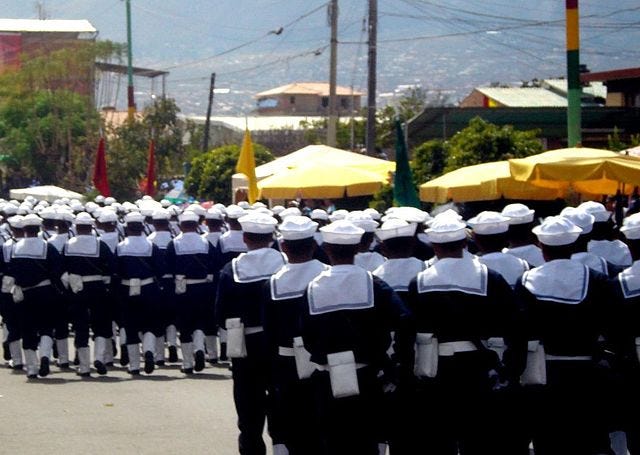The Adventures of the Bolivian Navy
Some more non-festive reading material – this time, on landlocked countries.
The second of our end of year trips into the archive. You can read the first, Day of the Tunnel Boring Machine, here.
One of the odder facts about the world I've come across recently is that there are two landlocked countries in South America – and both maintain navies.
A landlocked country, as you almost certainly know, is one which doesn’t have a coastline, thus requiring the locals to cross someone else’s sovereign territory to launch a naval flotilla and/or go to the beach. Some, like Lesotho or San Marino – are enclaves surrounded by one other country, which is a bit of a nightmare from a geopolitical point of view. Most, though, have more than one neighbour, and just happen to be sited some distance in-land.
Dry land: a map of landlocked countries since South Sudan’s independence in 2011. Image: Nuclear Vacuum/Wikimedia Commons.
The number of landlocked countries in the world has grown rather rapidly these last few decades. In 1990, there were 30; now, thanks to the break ups of Yugoslavia, Czechoslovakia, and the USSR, plus the creation of Eritrea and South Sudan, there are 44. Some of them – European microstates like San Marino, Andorra or the Vatican City – are diddy. Some of them, like Kazakhstan, which is nearly two-thirds the size of the entire European Union, are massive. Two of them – Uzbekistan and Liechtenstein – are double landlocked, which means a resident would need to cross two international boundaries if they fancied a paddle. As things stand, there are no triple landlocked countries, though there’s no theoretical bar to the possibility.
Actually, like all the most fun facts, “there are 44 landlocked countries in the world” is surprisingly contested, and on two different fronts. For one thing, it's surprisingly hard to pin down what counts as a state: 194 are universally recognised, but depending on how you want to define things there are perhaps another dozen that have pretty strong claims to de facto independence, of which four – Kosovo, South Ossetia, Transnistria, and Artsakh, the territory 90s fans may remember as Nagorno-Karabakh – don't have coast lines. (More on that, in a book extract, here.)
Secondly, what counts as access to the sea? Another partially recognised state, Palestine, has a coastline in Gaza, but not in the West Bank, where a majority of its population actually live: since there isn't free movement between the two, should that count as landlocked?
Then there's the fact that at least some of these landlocked countries seem to have – there’s no easy way of putting this – coastlines. Kazakhstan actually borders the Caspian Sea. So do Turkmenistan and Azerbaijan.
But that, despite its name, is not really a sea, but an endorheic basin: the water which drains into it doesn't continue to the oceans, but evaporates into the atmosphere. And so, the Caspian Sea is really just a lake – albeit a lake so big it contains upwards of 40% of all the water in all the lakes in the world. (Incidentally, some countries, notably Iran and Turkmenistan, have claimed that it should be a real sea, apparently because that means they get access to its oil and gas fields. Which, fair play, you probably would, wouldn't you.)
At any rate, the only way from the Caspian to the world's proper oceans is via the Volga-Don Canal to the Black Sea, which is too small for ocean going ships, and since the whole point of not being landlocked is “in the event of emergencies, you can still get things and people in and out via massive, massive boats”, this doesn't actually help.
None of this has stopped various landlocked countries from maintaining a navy. Some of them play defensive functions, some merely logistical ones; some of them are mere units of the army, some a fully-fledged arm of the military in their own right. Switzerland has a “lakes flotilla”, which patrols and offers search and rescue functions within its various lakes, as well as a full merchant marine which takes imports and exports to the world via the Rhine. The Ethiopian Navy survived for several years after it lost its coastline via Eritrean independence in 1991, and has considered creating a new one to defend its maritime influence. (Sadly I have not been able to verify the widely reproduced zombie factoid that it still maintains a single boat on Lake Tana.1)
Then there's Hungary, which according to a Wikipedia page I suspect of having been edited by the Hungarian authorities, “has one of the heaviest and most qualified warship battalions in East-Central Europe”. Over in the Americas, Paraguay has a surprisingly large navy which patrols the Paraguay and Paraná rivers, and which could, if required, use them to break out into the Atlantic via Argentina.
Bolivian marines, marching in Cochabamba, approximately 280 miles inland. Image: Israel_Soliz/Wikimedia Commons.
The fun one, though, is Bolivia, which lost its coastline to Chile in the War of the Pacific back in 1879-83, yet established a navy with help from the United States back in 1963. Its 5,000 or so troops patrol the waters of Lake Titicaca, in the heights of the Andes; but mainly they are a symbol of Bolivian national pride – and the hope that one day it will have access to the sea once again.
If you liked this email, and would like to receive one every week containing more, then you can become a paying subscriber for £4 a month, or £40 a year: either way, that’s less than £1 a week.
Questions? Suggestions? Complaints? Leave a comment:




